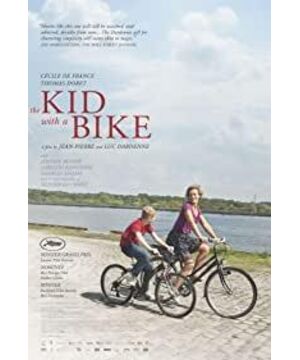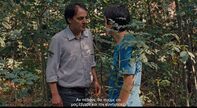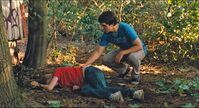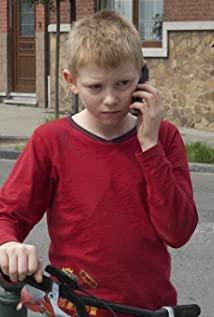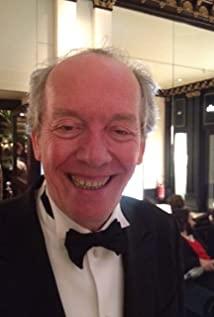1. The composition of the scene in the film (mid-range narrative, close-up emphasizing emotion)
1. This film uses character communication to show the development of the story, so the medium-range is more used in the exchange of characters. This scene mainly shows the behavior of the upper body of the character. The focus of the composition is more on the relationship between the half-length body of the character, the emotional communication, and the relationship between the character and the character. Therefore, the middle shot accounts for a large proportion of the whole movie. In the film, Cyril’s perspective is used as the narrative mode in the process of interaction with father, adoptive mother Samantha, and bad boy. Give the audience a more real and distance experience. It is also more in line with the recording concept of "follow the characters" used by the director. In addition, the medium shot also considers the environment in the composition of the picture, and the use of large pages will not lose the sense of environmental presence.
2. In addition to the middle shot used in narration, close-up shots are another lens language interspersed in the core of the story. The close-up shots are very penetrating and expressive, which can convey the narrative and influence the psychology of the audience. The expression of facial expressions can reveal the deeper part of the character's image and reflect the character's richer emotions. In the film, Cyril's inner and emotional changes are more represented by close-up facial expressions and eyes. The expressions of fear, perseverance, tenacity and helplessness are accurately and vividly portrayed through close-ups. In the whole picture, the details are visually emphasized and prominent, and because the different changes of the protagonist play the role of the node of the film, it reflects the simple and most realistic inner world of Cyril, the child's psychological suggestion to the audience. Obviously, it makes people feel like they are in it, and the perspective completely follows this child. The film focuses on the two scenes of the middle shot and the close-up. The middle shot focuses on storytelling. The close-up shows the changes in the inner emotions and outer behavior of Cyril in the first person. Although there is no complicated lens language, only these two shots Interweaving is enough to bring us into the world of Cyril.
2. The use of the lens in the film and the image pattern (combination of dynamic and static)
1. The point of view of the film unfolds from the subjective point of view of the characters in the play. What you see is entirely from the perspective of a child, without the director’s self-addition, and without the viewer’s imagination of similarity. This is a child telling a story with his own experience.
2. The position of the person who constitutes the main body of the lens is based on the environment where Cyril is located. Her position in the lens is always unique. This is Cyril's unique self-experience. In the film, most of the communication and chasing scenes, so the front-to-back and opposite-side arrangements occupy most of the format. Cyril’s position is not deliberate, but the way the camera follows Cyril, which is the most true and natural form of recording his life, so the audience’s point of view is always focused on Cyril’s body and will not be affected by other points of view. Attracted.
3. This movie uses more action shots, and it is relatively rare in the use of relational shots and rendering shots. It is also determined by the recording characteristics of this film. Action shots emphasize strengthening the continuity of the story, and more emphasis on the role of the characters in the film. The description of the environment has also become less, and the whole movie has no deliberate intervals and pauses. Action shots are visible in visual expression. The camera arrangement has a strengthening effect on the narrative foundation (dialogue), narrative focus (action details), and narrative rendering (action method). In the film, communication and dialogue are the most important way of behavior. You will know Cyril's experience and story by talking and behaving, and the details are the focus of describing the heart. From the beginning of the film, standing downstairs and constantly ringing the doorbell, knocking on the door, riding a bike to find his father, and then giving his father money and being rejected by his father, this series of character actions have vividly shown Cyril’s treatment of his father. Love is a kind of silent giving. The action shots in the film also pay great attention to the coordination of movement and stillness. Cyril with a fierce personality is active and manic. Quiet Cyril is lonely and lonely, resistant to anything.
The motion lens not only tells this story for us, but also step by step into Cyril's life and heart with the lens. Cyril who resists is always running, and Cyril who is quiet is always so resisting. Until I was cared and experienced setbacks.
3. The composition of the film and the movement of the camera (running and speeding bicycles)
1. "Cycling Boy" belongs to the documentary composition style, and the development of the story drives the composition. Change the composition form with the change of the character's psychological mood, bring about the change of the rhythm, and highlight the dramatic change of the story.
2. The boy's bicycle is one of the clues of the story. It is this bicycle that makes the rhythm of the whole film change and makes the whole film move. Continuous cycling is always interspersed in the picture, but many of them are trajectories with oblique angles, which represent the intense Cyril inside. When running, it also runs in a diagonal direction, which divides the picture and forms a visual impact, breaks the balance of the calm story, and reflects the changing process of the characters' hearts. When Cyril is in a good mood riding a bicycle, he is leisurely, riding parallel to the picture. The picture shows the boy's mood and attitude through different riding angles. Through the clever design of the composition, the heart of the characters is mastered, which is also the highlight of the story of the guide speech. Cyril is always riding a bike in his mind. The most important thing to ignore is the difference between composition and movement.
3. The movement in the film forms the rhythm of the film. Sports shots are the main shooting technique. The director used a lot of hand-held shooting, which caused a sense of instability to make the story more real and expressive. When the characters are moving and the camera is fixed, the tempo slows down, and the tempo of the entire film is controlled.
4. The use of a large number of lens shifts. In order to match the fast-moving bicycle, the lateral movement and the follow-up of the objective lens are combined into a set of coherent shots. In addition to speed and handheld follow-up, the combination with the composition of the picture constitutes a complete video story. And the combination of the lateral shift and lengthened lens at the end is smooth and soft. This change in speed actually gives the film a special taste.
5. The use of long shots in the film. Cyril was followed by long-lens shots in many places in the film, and most of them were fast following him on the run or cycling on the street. It is fast, and the scene has changed, which enriches the sense of the picture when the character is in motion. The long shot is also an important aspect of the character's psychological description. Let the audience easily understand the boy's inner mania and inner thoughts. As the film continues to deepen, Cyril has been changing. The slower and more stable performance of the lens is also the most important portrayal of this boy.
4. Sound expresses Cyril's inner world (understand the world with children's logic and cognition)
1. Follow-up and more dialogues and exchanges. The lens brings ambient sound and human voices to the whole film. The discontinuity and connection of speech is the easiest way to show emotions. Outburst is opposite to silence. Cyril's explosive power is more reflected in the front part, which has a lot to do with his father's love for bicycles. The later flashpoints and silence are more of a struggle between inner loneliness and trust. The director used the most unchanged environmental voice to express the child's attitude towards people, things, and things. Children express everything with their own behavioral logic. This is the most realistic perspective of this film.
2. The use of soundtrack. The Darnet brothers rarely use the soundtrack in the movie, but in this movie they broke through the convention and added a piece of music with a small climax. In the use of the soundtrack, the space is not large, and the soundtrack has been added to a total of four time nodes. They were lying helplessly on the bed in the orphanage without finding their father, hearing his father telling himself not to look for himself again, his father rejected the money he stolen, and finally cycling with Samantha. Obviously, this soundtrack was used at emotional bursts. Although the soundtrack does not have too much meaning, it has the effect of strengthening emotional expression. The appearance of the soundtrack surprised the audience, and even caused the audience to suddenly start twists and turns from the story. But for the protagonist, these four time points are the most important part of this childhood experience, allowing him to understand a lot and grow up a lot. From helplessness to happiness, his experience and the changes he made to himself are all startling and thought-provoking.
5. Color The prominent
colors of the film are mostly natural and simple. But for the core character Cyril, it is always the red dress. Every picture is dazzling, not only he is the core of the story, but every conflict is based on him. Red is the representative of fierceness and passion. And Cyril's heart is like this red is so prominent. Conflict and contradiction are described around that kind of red. As the story progressed, Cyril, who finally fell under the tree, stood up, patted the dust on his body, and rode away on his bicycle. It seems that red has stopped flowing at this time. Some are a kind of faint sadness, but also a manifestation of his inner peace. He completed the redemption, completed the apology to others. Red is no longer passionate, but simpler.
A story like "Boy Boy", the growing up experience of a little boy, may be unbelievable and incomprehensible to many people. His ideas seem so simple, but he is so persistent, none of this can be understood by an adult. Because this is a child, Cyril's perspective, this is his story in his heart. The director prevented all adult thoughts from affecting the children's experience without adding personal factors.
In my opinion, maybe this is a kind of memory, a kind of aftertaste for everyone. When you think about your childhood, there are many things you can't understand now when you think about it. The children at that time, innocent and simple, were clinging to their own thoughts. When you watch this movie and remember your past, you can get the same answer as Cyril-a story of childhood.
View more about The Kid with a Bike reviews


